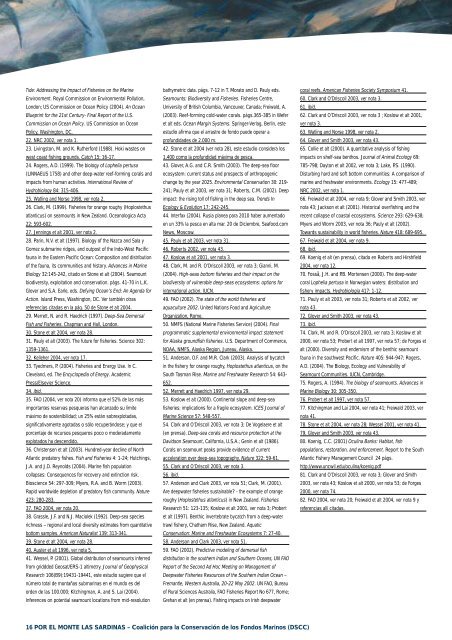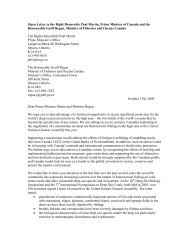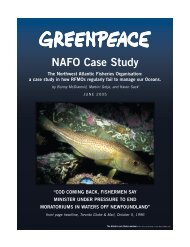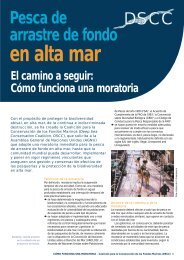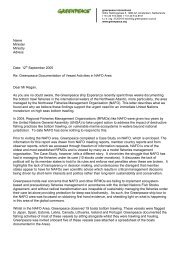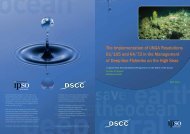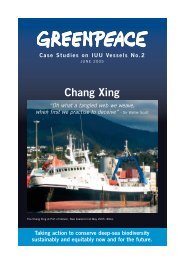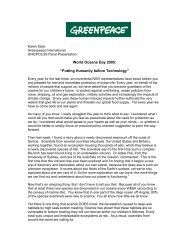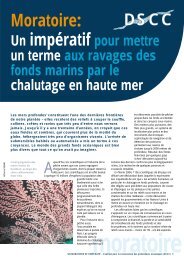Por el mar corren las liebres, por el monte las sardinas.
Por el mar corren las liebres, por el monte las sardinas.
Por el mar corren las liebres, por el monte las sardinas.
You also want an ePaper? Increase the reach of your titles
YUMPU automatically turns print PDFs into web optimized ePapers that Google loves.
Tide: Addressing the Impact of Fisheries on the Marine<br />
Environment. Royal Commission on Environmental Pollution,<br />
London; US Commission on Ocean Policy (2004). An Ocean<br />
Blueprint for the 21st Century- Final Re<strong>por</strong>t of the U.S.<br />
Commission on Ocean Policy. US Commission on Ocean<br />
Policy, Washington, DC.<br />
22. NRC 2002, ver nota 1.<br />
23. Livingston, M. and K. Rutherford (1988). Hoki wastes on<br />
west coast fishing grounds. Catch 15: 16-17.<br />
24. Rogers, A.D. (1999). The biology of Loph<strong>el</strong>ia pertusa<br />
(LINNAEUS 1758) and other deep-water reef-forming corals and<br />
impacts from human activities. International Review of<br />
Hydrobiology 84: 315-406.<br />
25. Watling and Norse 1998, ver nota 2.<br />
26. Clark, M. (1999). Fisheries for orange roughy (Hoplostethus<br />
atlanticus) on seamounts in New Zealand. Oceanologica Acta<br />
22: 593-602.<br />
27. Jennings et alt 2001, ver nota 2.<br />
28. Parin, N.V. et alt (1997). Biology of the Nazca and Sala y<br />
Gomez sub<strong>mar</strong>ine ridges, and outpost of the Indo-West Pacific<br />
fauna in the Eastern Pacific Ocean: Composition and distribution<br />
of the fauna, its communities and history. Advances in Marine<br />
Biology 32:145-242, citado en Stone et alt (2004). Seamount<br />
biodiversity, exploitation and conservation. págs. 41-70 in L.K.<br />
Glover and S.A. Earle, eds. Defying Ocean’s End: An Agenda for<br />
Action. Island Press, Washington, DC. Ver también otras<br />
referencias citadas en la pág. 50 de Stone et alt 2004.<br />
29. Merrett, N. and R. Haedrich (1997). Deep-Sea Demersal<br />
Fish and Fisheries. Chapman and Hall, London.<br />
30. Stone et alt 2004, ver nota 28.<br />
31. Pauly et alt (2003). The future for fisheries. Science 302:<br />
1359-1361.<br />
32. K<strong>el</strong>leher 2004, ver nota 17.<br />
33. Tyedmers, P. (2004). Fisheries and Energy Use. In C.<br />
Clev<strong>el</strong>and, ed. The Encyclopedia of Energy. Academic<br />
Press/Elsevier Science.<br />
34. ibid.<br />
35. FAO (2004, ver nota 20) informa que <strong>el</strong> 52% de <strong>las</strong> más<br />
im<strong>por</strong>tantes reservas pesqueras han alcanzado su límite<br />
máximo de sostenibilidad; un 25% están sobrexplotadas,<br />
significativamente agotadas o sólo recuperándose; y que <strong>el</strong><br />
<strong>por</strong>centaje de recursos pesqueros poco o moderadamente<br />
explotados ha descendido.<br />
36. Christensen et alt (2003). Hundred-year decline of North<br />
Atlantic predatory fishes. Fish and Fisheries 4: 1-24; Hutchings,<br />
J.A. and J.D. Reynolds (2004). Marine fish population<br />
collapses: Consequences for recovery and extinction risk.<br />
Bioscience 54: 297-309; Myers, R.A. and B. Worm (2003).<br />
Rapid worldwide depletion of predatory fish community. Nature<br />
423: 280-283.<br />
37. FAO 2004, ver nota 20.<br />
38. Grassle, J.F. and N.J. Maciolek (1992). Deep-sea species<br />
richness – regional and local diversity estimates from quantitative<br />
bottom samples. American Naturalist 139: 313-341.<br />
39. Stone et alt 2004, ver nota 28.<br />
40. Auster et alt 1996, ver nota 5.<br />
41. Wess<strong>el</strong>, P. (2001). Global distribution of seamounts inferred<br />
from griddded Geosat/ERS-1 altimetry. Journal of Geophysical<br />
Research 106(B9):19431-19441, este estudio sugiere que <strong>el</strong><br />
número total de montañas sub<strong>mar</strong>inas en <strong>el</strong> mundo es d<strong>el</strong><br />
orden de <strong>las</strong> 100.000; Kitchingman, A. and S. Lai (2004).<br />
Inferences on potential seamount locations from mid-resolution<br />
bathymetric data. págs. 7-12 in T. Morato and D. Pauly eds.<br />
Seamounts: Biodiversity and Fisheries. Fisheries Centre,<br />
University of British Columbia, Vancouver, Canada; Freiwald, A.<br />
(2003). Reef-forming cold-water corals. págs.365-385 in Wefer<br />
et alt eds. Ocean Margin Systems. Springer-Verlag, Berlin, este<br />
estudio afirma que <strong>el</strong> arrastre de fondo puede operar a<br />
profundidades de 2.000 m.<br />
42. Stone et alt 2004 (ver nota 28), este estudio considera los<br />
1.400 como la profundidad máxima de pesca.<br />
43. Glover, A.G. and C.R. Smith (2003). The deep-sea floor<br />
ecosystem: current status and prospects of anthropogenic<br />
change by the year 2025. Environmental Conservation 30: 219-<br />
241; Pauly et alt 2003, ver nota 31; Roberts, C.M. (2002). Deep<br />
impact: the rising toll of fishing in the deep sea. Trends In<br />
Ecology & Evolution 17: 242-245.<br />
44. Interfax (2004). Rusia planea para 2010 haber aumentado<br />
en un 33% la pesca en alta <strong>mar</strong>. 20 de Diciembre, Seafood.com<br />
News, Moscow.<br />
45. Pauly et alt 2003, ver nota 31.<br />
46. Roberts 2002, ver nota 43.<br />
47. Koslow et alt 2001, ver nota 3.<br />
48. Clark, M. and R. O’Driscoll 2003, ver nota 3; Gianni, M.<br />
(2004). High-seas bottom fisheries and their impact on the<br />
biodiversity of vulnerable deep-seas ecosystems: options for<br />
international action. IUCN.<br />
49. FAO (2002). The state of the world fisheries and<br />
aquaculture 2002. United Nations Food and Agriculture<br />
Organization, Rome.<br />
50. NMFS (National Marine Fisheries Service) (2004). Final<br />
programmatic supplemental environmental impact statement<br />
for A<strong>las</strong>ka groundfish fisheries. U.S. Department of Commerce,<br />
NOAA, NMFS, A<strong>las</strong>ka Region, Juneau, A<strong>las</strong>ka.<br />
51. Anderson, O.F. and M.R. Clark (2003). Analysis of bycatch<br />
in the fishery for orange roughy, Hoplostethus atlanticus, on the<br />
South Tasman Rise. Marine and Freshwater Research 54: 643-<br />
652.<br />
52. Merrett and Haedrich 1997, ver nota 29.<br />
53. Koslow et alt (2000). Continental slope and deep-sea<br />
fisheries: implications for a fragile ecosystem. ICES Journal of<br />
Marine Science 57: 548-557.<br />
54. Clark and O’Driscoll 2003, ver nota 3; De Vog<strong>el</strong>aere et alt<br />
(en prensa). Deep-sea corals and resource protection at the<br />
Davidson Seamount, California, U.S.A.; Genin et alt (1986).<br />
Corals on seamount peaks provide evidence of current<br />
acc<strong>el</strong>eration over deep-sea topography. Nature 322: 59-61.<br />
55. Clark and O’Driscoll 2003, ver nota 3.<br />
56. ibid.<br />
57. Anderson and Clark 2003, ver nota 51; Clark, M. (2001).<br />
Are deepwater fisheries sustainable? - the example of orange<br />
roughy (Hoplostethus atlanticus) in New Zealand. Fisheries<br />
Research 51: 123-135; Koslow et alt 2001, ver nota 3; Probert<br />
et alt (1997). Benthic invertebrate bycatch from a deep-water<br />
trawl fishery, Chatham Rise, New Zealand. Aquatic<br />
Conservation: Marine and Freshwater Ecosystems 7: 27-40.<br />
58. Anderson and Clark 2003, ver nota 51.<br />
59. FAO (2002). Predictive mod<strong>el</strong>ing of demersal fish<br />
distribution in the southern Indian and Southern Oceans, UN FAO<br />
Re<strong>por</strong>t of the Second Ad Hoc Meeting on Management of<br />
Deepwater Fisheries Resources of the Southern Indian Ocean –<br />
Fremantle, Western Australia, 20-22 May 2002. UN FAO, Bureau<br />
of Rural Sciences Australia, FAO Fisheries Re<strong>por</strong>t No 677, Rome;<br />
Grehan et alt (en prensa). Fishing impacts on Irish deepwater<br />
coral reefs. American Fisheries Society Symposium 41.<br />
60. Clark and O’Driscoll 2003, ver nota 3.<br />
61. ibid.<br />
62. Clark and O’Driscoll 2003, ver nota 3 ; Koslow et alt 2001,<br />
ver nota 3.<br />
63. Watling and Norse 1998, ver nota 2.<br />
64. Glover and Smith 2003, ver nota 43.<br />
65. Collie et alt (2000). A quantitative analysis of fishing<br />
impacts on sh<strong>el</strong>f-sea benthos. Journal of Animal Ecology 69:<br />
785-798; Dayton et alt 2002, ver nota 3; Lake, P.S. (1990).<br />
Disturbing hard and soft bottom communities: A comparison of<br />
<strong>mar</strong>ine and freshwater environments. Ecology 15: 477-489;<br />
NRC 2002, ver nota 1.<br />
66. Freiwald et alt 2004, ver nota 9; Glover and Smith 2003, ver<br />
nota 43; Jackson et alt (2001). Historical overfishing and the<br />
recent collapse of coastal ecosystems. Science 293: 629-638;<br />
Myers and Worm 2003, ver nota 36; Pauly et alt (2002).<br />
Towards sustainability in world fisheries. Nature 418: 689-695.<br />
67. Freiwald et alt 2004, ver nota 9.<br />
68. ibid.<br />
69. Koenig et alt (en prensa), citado en Roberts and Hirshfi<strong>el</strong>d<br />
2004, ver nota 12.<br />
70. Fosså, J.H. and P.B. Mortensen (2000). The deep-water<br />
coral Loph<strong>el</strong>ia pertusa in Norwegian waters: distribution and<br />
fishery impacts. Hydrobiologia 417: 1-12.<br />
71. Pauly et alt 2003, ver nota 31; Roberts et alt 2002, ver<br />
nota 43.<br />
72. Glover and Smith 2003, ver nota 43.<br />
73. ibid.<br />
74. Clark, M. and R. O’Driscoll 2003, ver nota 3; Koslow et alt<br />
2000, ver nota 53; Probert et alt 1997, ver nota 57; de Forges et<br />
alt (2000). Diversity and endemism of the benthic seamount<br />
fauna in the southwest Pacific. Nature 405: 944-947; Rogers,<br />
A.D. (2004). The Biology, Ecology and Vulnerability of<br />
Seamount Communities. IUCN, Cambridge.<br />
75. Rogers, A. (1994). The biology of seamounts. Advances in<br />
Marine Biology 30: 305-350.<br />
76. Probert et alt 1997, ver nota 57.<br />
77. Kitchingman and Lai 2004, ver nota 41; Freiwald 2003, ver<br />
nota 41.<br />
78. Stone et alt 2004, ver nota 28; Wess<strong>el</strong> 2001, ver nota 41.<br />
79. Glover and Smith 2003, ver nota 43.<br />
80. Koenig, C.C. (2001) Oculina Banks: Habitat, fish<br />
populations, restoration, and enforcement. Re<strong>por</strong>t to the South<br />
Atlantic Fishery Management Council 24 págs.<br />
http://www.uncwil.edu/oculina/koenig.pdf<br />
81. Clark and O’Driscoll 2003, ver nota 3; Glover and Smith<br />
2003, ver nota 43; Koslow et alt 2000, ver nota 53; de Forges<br />
2000, ver nota 74.<br />
82. FAO 2004, ver nota 20; Freiwald et alt 2004, ver nota 9 y<br />
referencias allí citadas.<br />
16 POR EL MONTE LAS SARDINAS – Coalición para la Conservación de los Fondos Marinos (DSCC)


